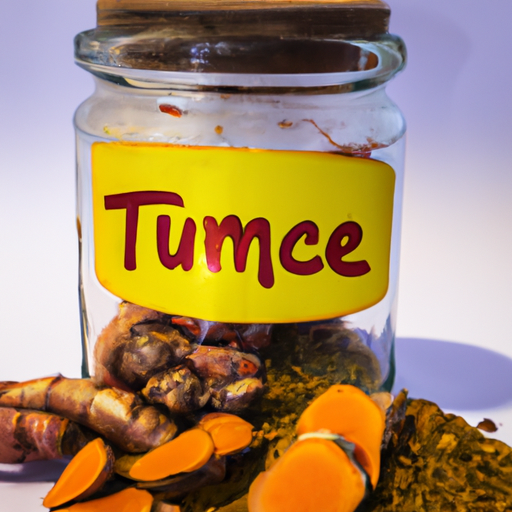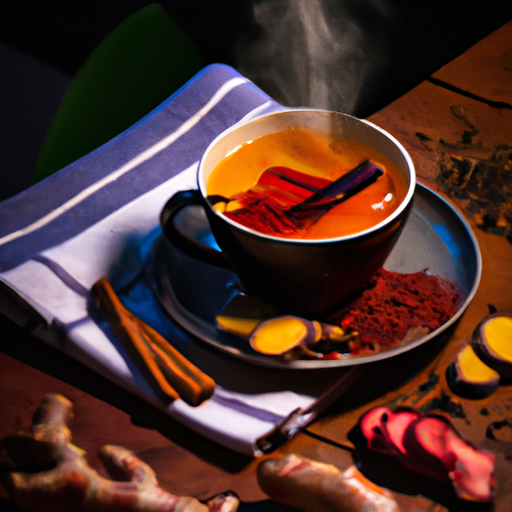Hello, tea lovers! Are you feeling unwell and searching for a natural solution to strengthen your immune system? Or are you just in need of a soothing and relaxing drink to unwind at the end of a busy day?
Well, I have just the thing for you – fresh ginger turmeric tea! Now, before you dismiss this as another fad health drink, let me assure you that both ginger and turmeric have been used for centuries in Ayurvedic medicine to treat various ailments.
Ginger is known for its anti-inflammatory and antioxidant properties while turmeric contains curcumin which has been found to have numerous health benefits. Combined together in a soothing cup of tea, these two ingredients make for a powerful elixir that not only tastes great but also provides an array of health benefits.
So grab your apron and let’s get brewing!
Key Takeaways
- Fresh ginger turmeric tea is a natural remedy that can boost immunity and provide comfort.
- The combination of ginger and turmeric provides numerous health benefits that have been scientifically proven.
- High-quality filtered or spring water should be used for optimal taste and health benefits.
- Natural sweeteners like honey or maple syrup are recommended over artificial sweeteners, and black pepper can enhance the absorption of turmeric’s anti-inflammatory properties.
Benefits of Fresh Ginger Turmeric Tea
You’ll be amazed at how much better you’ll feel after just one cup of this delicious fresh ginger turmeric tea. It’s packed with amazing health benefits that will leave you feeling revitalized and full of energy!
The combination of ginger and turmeric provides numerous health benefits that have been scientifically proven. Ginger has anti-inflammatory properties that help reduce muscle soreness and joint pain. It also aids in digestion, relieves nausea, and boosts the immune system.
Meanwhile, turmeric boasts powerful antioxidant properties that protect against free radicals and inflammation. Turmeric is known to alleviate symptoms of depression, lower cholesterol levels, improve brain function, and aid in weight loss.
With all these impressive health benefits combined in a single drink, it’s no wonder why fresh ginger turmeric tea is gaining popularity among health enthusiasts worldwide! If you’re interested in trying out different recipe variations for this amazing tea or learning about the ingredients needed for this recipe, keep on reading!
Ingredients Needed
For my fresh ginger turmeric tea, I need four simple ingredients: fresh ginger root, fresh turmeric root, water, and optionally a sweetener of my choice.
The combination of these ingredients creates a flavorful and nutrient-rich beverage that can help improve digestion and boost immunity.
As someone who prioritizes health and wellness, I’m excited to explore the benefits of these powerful roots through this delicious tea recipe.
Fresh Ginger Root
Ginger root, a staple in many households, contains anti-inflammatory compounds that can help reduce muscle soreness and joint pain. It’s also known to aid digestion and boost immunity. To make fresh ginger turmeric tea, it’s important to use fresh ginger root instead of powdered ginger or ginger tea blends.
One way to incorporate fresh ginger into your daily routine is by juicing it with other vegetables and fruits. Ginger juice can be added to smoothies or used as a base for a homemade salad dressing. Another option is steeping sliced or grated ginger in hot water for several minutes to make a soothing cup of ginger tea.
By using fresh ginger root in your tea, you’ll experience the full flavor and benefits of this powerful root.
Moving on to the next subtopic, let’s discuss how fresh turmeric root can be used in making turmeric tea.
Fresh Turmeric Root
If you’re looking for a new way to add some zest to your diet, consider incorporating fresh turmeric root into your daily routine. This bright orange root is similar in appearance to ginger, but with a slightly more bitter taste. Here are some cooking tips and health benefits of fresh turmeric that you may find useful:
- Add grated or sliced fresh turmeric root to smoothies for an extra boost of antioxidants and anti-inflammatory compounds.
- Use fresh turmeric in place of powdered turmeric in recipes for a brighter color and more potent flavor.
- Pair fresh turmeric with black pepper to enhance its absorption and maximize its health benefits.
- Try making a simple tea by simmering sliced fresh turmeric root in water for 10 minutes, then adding honey or lemon juice to taste.
Not only does fresh turmeric add flavor and color to dishes, it also has numerous health benefits. The active compound in turmeric, curcumin, has been shown to have anti-inflammatory effects and may help reduce the risk of chronic diseases such as heart disease and cancer. So next time you’re at the grocery store, pick up some fresh turmeric root and start reaping its many benefits.
Now let’s move on to the next step: preparing the water for our ginger-turmeric tea.
Water
To get started with our refreshing ginger-turmeric concoction, we’ll need to boil some water first. Water is essential for our body’s hydration needs. It helps regulate body temperature, aids digestion, and keeps our skin healthy.
Drinking enough water every day is crucial for maintaining optimal health. When it comes to the best time to drink water, it’s recommended to sip on fluids throughout the day rather than chugging a large amount at once. This ensures that your body stays hydrated consistently and helps prevent dehydration-related symptoms such as headaches and fatigue.
As we prepare our ginger-turmeric tea, let’s remember the importance of hydration and make sure we’re getting enough water throughout the day. Moving on to the subsequent section about sweetener (optional), we can add honey or maple syrup if desired for a touch of sweetness without adding processed sugars.
Sweetener (Optional)
You may want to consider adding a natural sweetener such as honey or maple syrup to enhance the flavor of your ginger-turmeric concoction. While these sweeteners provide a tasty addition, it’s important to note that excessive consumption of added sugars can have negative health effects. Luckily, there are natural sweetener alternatives available for those who want to avoid the harmful effects of sugar.
Here are three natural sweetener alternatives you can use in your ginger-turmeric tea:
-
Stevia: This plant-based sweetener has zero calories and doesn’t affect blood sugar levels.
-
Dates: These fruits add sweetness while also providing essential nutrients like fiber and potassium.
-
Cinnamon: This spice adds sweetness and has been shown to improve blood sugar control in people with diabetes.
As we move on to discussing the equipment needed to make this healthy beverage, keep in mind that adding a natural sweetener is optional but can enhance the overall taste experience.
Equipment Needed
The only equipment you’ll need for making fresh ginger turmeric tea is a pot and a grater. It’s that simple! You can use any pot you have at home, but if you’re looking to invest in one, I recommend checking out brands like Le Creuset or Cuisinart for high-quality options. However, if you’re on a budget, there are plenty of great options available as well. For example, the Amazon Basics Stainless Steel Non-Stick Cookware Set is an affordable option that includes all the pots and pans you’ll need for cooking and brewing tea.
Another alternative to traditional teapots is using a French press. This method works great for making small batches of tea and allows you to easily strain out any bits of ginger or turmeric that may be left behind. To help visualize the different options available, take a look at this table:
| Equipment | Recommended Brands | Budget Options |
|---|---|---|
| Pot | Le Creuset | Amazon Basics Stainless Steel Non-Stick Cookware Set |
| Grater | Microplane | OXO Good Grips Etched Box Grater |
| French Press | Bodum | Ikea Upphetta |
Now that we have our equipment ready, let’s move on to the step-by-step process!
Step-by-Step Process
To make fresh ginger turmeric tea, I begin by preparing the ingredients. This involves peeling and grating fresh ginger root and turmeric.
Next, I boil water in a saucepan on the stove and add the grated ginger and turmeric to the water. After that, I let the mixture simmer for about 10 minutes.
Finally, I strain the tea to remove any solid pieces. This results in a delicious and healthy tea that’s perfect for any time of day.
Preparing the Ingredients
Mixing fresh ginger and turmeric is like creating a dynamic duo, where the spicy kick of ginger perfectly complements the earthy flavor of turmeric. These two ingredients not only add a delicious twist to your tea, but they’re also packed with health benefits that can boost your immune system and reduce inflammation.
Ginger contains compounds called gingerols, which have anti-inflammatory properties, while turmeric has curcumin, which helps to fight against oxidative stress in the body. To prepare this refreshing tea, start by peeling and slicing 1-2 inches of fresh ginger root and 1-2 teaspoons of fresh turmeric root into thin pieces.
As you slice through the roots, the sharp aroma of ginger will awaken your senses while the vibrant orange color of turmeric will catch your eye. Take a moment to inhale their potent fragrance and appreciate how these two simple ingredients can transform a cup of plain water into something special.
Then, move on to boiling the water for our next step in making this delightful tea.
Boiling the Water
Now you can feel the anticipation building as you watch the water come to a rolling boil in your favorite teapot or saucepan.
Boiling the water is an essential step in making fresh ginger turmeric tea, as it helps extract all of the beneficial compounds from these powerful roots. To ensure that your tea turns out just right, it’s important to use proper boiling technique and pay attention to water temperature.
When boiling the water for your ginger turmeric tea, be sure to use high-quality filtered or spring water for optimal taste and health benefits. Bring the water to a full boil over high heat, then reduce the heat slightly and let it simmer for a minute or two before adding in your ginger and turmeric. This will help release any impurities or chemicals that may be present in tap water and ensure a clean, pure flavor for your tea.
With this step done, we’re ready to move on to adding our ginger and turmeric into the pot!
Adding the Ginger and Turmeric
As you drop in the ginger and turmeric, their aromatic scent fills your senses, promising a warm and comforting experience that will nurture both your body and soul. Adding spices to tea is an age-old tradition that not only enhances flavor but also adds nutritional value.
Ginger is a natural anti-inflammatory agent that can help reduce muscle soreness, while turmeric boasts powerful antioxidant properties that may support brain function. To ensure maximum infusion of these beneficial ingredients, it’s important to follow proper infusion techniques when adding the ginger and turmeric.
Begin by peeling the ginger root and slicing it into thin pieces. Next, peel the turmeric root (or use ground turmeric) and add it to the pot with the ginger slices. Gently stir to allow for even distribution of spices throughout the water. With each swirl of your spoon, you’ll begin to see a beautiful golden hue emerge from this potent mixture.
As the fragrant steam rises up from your pot, it’s time to let this concoction simmer gently on low heat for about 10 minutes before straining into your cup. So now that we have our spices added in, let’s move on to letting the mixture simmer before enjoying all its benefits!
Letting the Mixture Simmer
While the mixture simmers, you may be surprised to learn that adding spices to tea can increase its antioxidant content by up to 13 times! This is because ginger and turmeric contain potent antioxidants called gingerol and curcumin, respectively. These compounds help protect your cells from damage caused by free radicals and may even have anti-inflammatory effects in the body.
To make sure you get the most out of these spices, it’s important to use proper simmering techniques. You don’t want the mixture to boil or cook too quickly, as this can cause the flavors to become bitter or overpowering. Instead, keep the heat low and let everything simmer gently for at least 10 minutes. This will give the ginger and turmeric time to release their aromatic oils and blend with the other ingredients for a delicious, well-balanced flavor.
Once your tea has simmered for long enough, it’s time to move on to straining it.
Straining the Tea
After the mixture’s simmered, it’s time to strain out any remaining solid ingredients for a smooth and clear tea. There are different methods to strain the tea, but I prefer using a fine mesh strainer or cheesecloth.
The fine mesh strainer can easily catch the small bits of ginger and turmeric while allowing the liquid to pass through smoothly. On the other hand, cheesecloth can be used if you want an ultra-smooth texture since it catches even finer particles.
Straining is crucial in making ginger turmeric tea because it removes any excess solids that might affect taste and texture. It ensures that your tea is free from unwanted bits that could ruin its overall flavor profile. Once strained, you’ll have a clear golden-yellow liquid that’s ready for drinking or sweetening (optional).
To add sweetener, simply stir in your desired amount of honey, agave, or sugar until it dissolves completely. Enjoy your homemade ginger turmeric tea!
Adding Sweetener (Optional)
Don’t forget, you can add sweetener to your ginger turmeric tea if desired. However, I recommend using natural sweeteners like honey or maple syrup instead of artificial ones. Here are four reasons why:
-
Artificial sweeteners have been linked to negative health effects such as weight gain and increased risk for diabetes.
-
Natural sweeteners contain beneficial nutrients and antioxidants that can help improve overall health.
-
Using natural sweeteners can enhance the flavor of the tea without adding unnecessary chemicals to your body.
-
Choosing natural sweeteners supports sustainable and ethical practices in food production.
Adding a touch of sweetness to your ginger turmeric tea is a great way to balance out its strong flavors while reaping the many health benefits it provides.
Now that you know about the options for sweetening your tea, let’s move on to some tips and tricks for making the perfect cup every time.
Tips and Tricks
Interestingly enough, adding a pinch of black pepper to your ginger turmeric tea can enhance the absorption of the turmeric’s anti-inflammatory properties. This is because black pepper contains a compound called piperine, which has been shown to increase the bioavailability of curcumin, the active ingredient in turmeric.
Additionally, if you want to infuse more flavors into your tea, you can try adding other herbal alternatives such as cinnamon or cardamom.
Another tip for making fresh ginger turmeric tea is to use high-quality ingredients. Choose fresh ginger and turmeric roots that are firm and free from mold or blemishes. It’s also important to use filtered water instead of tap water to avoid any impurities that may affect the taste and quality of your tea.
With these tips in mind, you can enjoy a delicious cup of ginger turmeric tea with maximum health benefits. Speaking of which, let’s move on to some serving suggestions for this wonderful beverage.
Serving Suggestions
Enhance the experience of drinking fresh ginger turmeric tea by adding a slice of lemon or honey. Not only do these additions add flavor, but they also provide additional health benefits. Lemon is rich in vitamin C and antioxidants, which can boost immunity and help with digestion. Honey has antibacterial properties that can soothe sore throats and calm coughs, making it great for those suffering from colds or flu.
When it comes to serving suggestions, I recommend pairing this tea with light snacks such as fruit or nuts. The spicy notes of ginger and earthy flavors of turmeric complement the sweetness of fruit while providing a satisfying crunch when paired with nuts.
As for serving size recommendations, one cup is sufficient for most people. However, you may want to increase your intake if you are using this tea to alleviate inflammation-related conditions such as arthritis or joint pain.
Moving onto precautions, it’s important to note that some individuals may experience side effects such as heartburn or stomach upset due to the strong nature of ginger and turmeric. In the next section, we’ll discuss some tips on how to safely consume this beverage without experiencing any adverse reactions.
Precautions
When it comes to consuming fresh ginger turmeric tea, it’s important to take certain precautions. As someone who’s experienced the benefits of this tea firsthand, I’ve also done my research on possible side effects and interactions with other substances.
It’s crucial to understand potential allergies, interference with medications, and other risks associated with consuming this tea regularly.
Possible Side Effects
To ensure you’re aware of any potential side effects, it’s important to note that consuming too much turmeric may cause stomach upset or diarrhea. While these side effects are usually mild and temporary, it’s still a good idea to start with small amounts of turmeric when making your ginger turmeric tea. Gradually increase the amount over time as your body adjusts.
It’s also worth noting that some people may be allergic to turmeric. If you experience symptoms such as hives, itching, or difficulty breathing after consuming turmeric, stop using it immediately and seek medical attention.
In the next section, we’ll discuss precautions for individuals with allergies and how to make sure your ginger turmeric tea is safe for consumption.
Allergies
If you suffer from allergies, it’s important to be aware of the potential risks associated with consuming ginger turmeric tea. While natural remedies and alternative medicine are often praised for their healing properties, they can also pose a risk to individuals with certain allergies.
Ginger and turmeric both contain compounds that have been known to cause allergic reactions in some people. If you have a history of allergic reactions to any type of food or herb, it’s best to consult with your healthcare provider before incorporating ginger turmeric tea into your diet.
It’s also important to pay attention to any symptoms that may arise after consuming the tea, such as itching, hives, or swelling. If you experience any adverse effects, discontinue use immediately and seek medical attention if necessary.
As we move onto the next section about interference with medications, it’s important to note that certain medications may also interact negatively with ginger turmeric tea.
Interference with Medications
Moving on from the previous subtopic on allergies, it’s essential to also consider how ginger turmeric tea may interfere with medications. As a virtual assistant, I’ve come across individuals who have experienced adverse effects when taking this tea alongside their prescription drugs. Although natural remedies can be beneficial for health, they can also pose risks and interactions that need to be considered.
It’s important to note that ginger and turmeric contain active compounds that can affect specific enzymes in the body responsible for metabolizing drugs. Therefore, drinking fresh ginger turmeric tea while on certain medications can impact their effectiveness or cause unwanted side effects. Some potential discussion ideas surrounding this topic are drug interactions and health conditions that may be affected by ginger turmeric tea, which will be further explored in the table below. Moving forward into variations, let’s take a look at some exciting ways to personalize your fresh ginger turmeric tea!
| Health Condition | Medications That May Interact | Potential Effects |
|---|---|---|
| Blood Pressure | Anticoagulants (warfarin) | Increased risk of bleeding |
| Diabetes | Insulin or other diabetes medication | Hypoglycemia (low blood sugar) |
| Gallstones/Bile Duct Obstruction | Antacids containing aluminum hydroxide/magnesium hydroxide/simethicone combination products | Decreased effectiveness of antacids |
| Heart Disease/Arrhythmia | Beta-blockers/Calcium channel blockers/Digoxin | Altered heart rate or rhythm |
| Hormonal Imbalance (e.g., PCOS) | Hormone replacement therapy/birth control pills | Reduced effectiveness of hormones |
As shown in the table above, there are various health conditions and medications that could interact with fresh ginger turmeric tea. It is crucial to consult with a healthcare provider before consuming this drink if you’re currently taking any prescription drugs. Additionally, some individuals may need to avoid this tea altogether due to their health status or the medications they’re taking. With that said, let’s move on to exploring some exciting variations of this delicious and nutritious drink!
Variations
I’m excited to share with you some variations of the ginger turmeric tea recipe that I’ve tried and enjoyed.
These include ginger turmeric lemon tea, ginger turmeric honey tea, and ginger turmeric green tea. Each variation has its unique flavor profile and health benefits.
In summary, this drink is known for its anti-inflammatory properties and ability to boost the immune system, among other things. I encourage you to try making these teas at home and see which one becomes your favorite!
Ginger Turmeric Lemon Tea
To make Ginger Turmeric Lemon Tea, start by grating fresh ginger and turmeric into a pot of boiling water. Allow the mixture to simmer for 5-10 minutes, until the water has taken on the vibrant yellow color of the turmeric and a strong aroma has developed.
Remove from heat and add a squeeze of fresh lemon juice to taste. This variation of ginger turmeric tea is great for those who prefer a slightly tangy flavor profile. It also includes the added benefits of vitamin C from the lemon juice, which can boost your immune system and help with digestion.
If you’re looking for other ways to incorporate ginger and turmeric into your diet, try making a ginger turmeric latte or adding them to your morning smoothie.
Next up, let’s explore how to make ginger turmeric honey tea.
Ginger Turmeric Honey Tea
For a sweeter twist on the classic ginger turmeric tea blend, try adding some honey to your concoction. Not only does it add a delicious flavor, but honey’s also been shown to have antibacterial properties and may even help soothe sore throats.
When making this drink, I like to use local raw honey to support my community and reap the benefits of its natural enzymes. If you’re feeling adventurous, you can take your ginger turmeric tea game up a notch by transforming it into a latte! Simply froth some milk (or non-dairy milk) and add it to your brewed tea mixture for a creamy and indulgent treat.
The addition of honey not only sweetens this cozy beverage but also provides additional health benefits. Now let’s move on to the next section about ginger turmeric green tea.
Ginger Turmeric Green Tea
I hope you enjoyed learning about the delicious and healing properties of Ginger Turmeric Honey Tea in our previous section. Now, I’d like to introduce you to another fantastic variation of this beloved tea: Ginger Turmeric Green Tea.
Green tea is a powerhouse when it comes to health benefits. It’s loaded with antioxidants and helps improve brain function, reduces inflammation, and can even help prevent chronic diseases. When combined with ginger and turmeric, the result is a flavorful drink that packs a serious punch. The combination of ginger and turmeric adds anti-inflammatory properties while also giving this tea a spicy kick that balances out the subtle bitterness of green tea.
If you’re looking for an invigorating drink that will boost your energy levels and provide numerous health benefits, then Ginger Turmeric Green Tea is definitely worth trying!
Health Benefits:
- Provides antioxidant protection
- Boosts brain function
Flavor Profile:
- Spicy
- Subtle bitterness from green tea
With its unique flavor profile and impressive health benefits, Ginger Turmeric Green Tea is truly something special. In our next section, we’ll take a look at the summary of benefits that these teas have to offer so you can decide which one works best for your needs.
Summary of Benefits
Don’t miss out on the multitude of health benefits that Ginger Turmeric Green Tea can provide for you. This tea is packed with powerful antioxidants and anti-inflammatory compounds such as gingerol and curcumin, which have been shown through scientific research to have numerous health benefits.
These include reducing inflammation in the body, improving brain function, lowering cholesterol levels, boosting immunity, and even aiding in weight loss. Studies have also suggested that these two ingredients may work synergistically together to enhance their individual therapeutic effects.
So not only does Ginger Turmeric Green Tea taste delicious, it also has a myriad of health benefits to offer. Try incorporating this tea into your daily routine for a natural way to promote overall wellness and vitality.
Encouragement to Try the Recipe
After learning about the many benefits of fresh ginger turmeric tea, I’m excited to encourage you to try making this delicious and healthy beverage at home. It may seem intimidating at first, but trust me when I say it’s worth the effort.
Encouragement is key when trying something new, and making this tea is no exception. Not only will you be treating your body to a powerful dose of antioxidants and anti-inflammatory compounds, but the process of creating the tea can be quite meditative and relaxing.
Give yourself permission to experiment with different ratios of ginger and turmeric, or add in other ingredients like honey or lemon for added flavor. Making fresh ginger turmeric tea may become a beloved daily ritual that leaves you feeling energized and nourished from the inside out.
Frequently Asked Questions
What are the potential side effects of consuming too much ginger turmeric tea?
Excessive consumption of ginger turmeric tea may lead to gastrointestinal issues and interfere with certain medications. Long term effects are not well studied, but a recommended daily intake is 1-3 grams of ginger and up to 500mg of turmeric.
Can this tea be made with powdered ginger and turmeric instead of fresh?
Powdered ginger and turmeric can be used to make tea, but the flavor will differ from using fresh ingredients. Powdered forms are more convenient, but may lack some of the nutritional benefits found in fresh versions.
How long can fresh ginger and turmeric be stored before they go bad?
Coincidentally, I recently researched storing fresh spices. The shelf life of ginger and turmeric depends on preservation methods. Spice storage tips include refrigeration and freezing to maintain quality and preserve flavors. Cooking with fresh spices offers endless culinary uses, recipe ideas, spice pairings, and flavor combinations.
Is it safe to drink this tea while pregnant or breastfeeding?
As a healthcare professional, I advise pregnant women and breastfeeding mothers to exercise caution when consuming ginger turmeric tea. While both herbs are generally considered safe in moderate amounts, pregnancy concerns and breastfeeding safety should be discussed with a healthcare provider beforehand.
Are there any medications that should not be taken with ginger turmeric tea?
Drug interactions should be considered when consuming ginger turmeric tea. It may interact with blood thinners, diabetes medications, and others. The recommended dosage is 1-3 grams per day for general health benefits.
Conclusion
In conclusion, making fresh ginger turmeric tea is a simple and easy way to incorporate health benefits into your daily routine. The combination of these two powerful ingredients has been said to aid in digestion, boost immunity, reduce inflammation, and even improve brain function. While the scientific evidence behind these claims may still be limited, it’s worth exploring for those looking for natural remedies.
Furthermore, by using fresh ingredients and avoiding processed teas or supplements, you can ensure that you’re getting the most out of each sip. So why not give it a try? Whether you’re looking for a warm beverage on a chilly day or searching for ways to support your overall wellness journey, this tea may just become your new go-to drink.










